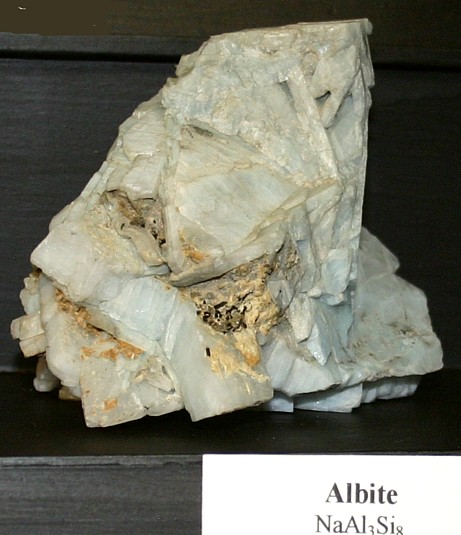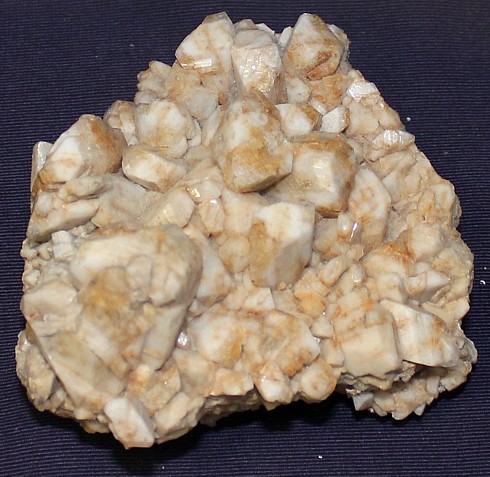|
.
Albite Mineral Facts:
Chemical Formula: NaAlSi3O8
The
Sodium-aluminum silicate, Silica 68.7%, alumina 19.5%, soda 11.8%.
Calcium is usually present in a small amount in the form of the
anorthite
molecule.
Colors:
Colorless, white, gray.
Sometimes with a bluish, greyish, reddish, or greenish tinge, The streak
nearly colorless or white.
Hardness:
6
Density: 2.62
Cleavage:
Two cleavages, one
p[erfect cleavage
parallel to basal plane, one almost as perfect parallel to the brachypinacoid.
The angle between the basal plane and this twinning plane is not 90, but
about 86 degrees. basal cleavages very frequently exhibit parallel
striations when they are examined in light reflected at the proper
angles.
Crystallography: Triclinic
Often found
in crystals, usually in tabular crystals parallel to the brachypinacoid.
Sometimes elongated parallel to the b crystal axis. Twinning very
common, according to the albite law and evidenced by fine
striation lines on the better cleavage surface. Twinning according to
the other feldspar twin laws is less frequent. Commonly massive, either
lamellar with lamellae often curved or in cleavable masses. Distinct
crystals are rare.
Luster:.
Vitreous luster that is
nearly pearly on
the cleavage planes. It is transparent to opaque.
|

Albite Feldspar |
|
Composition,
Structure and Associated Minerals:
Albite a widely
distributed and important
rock-making mineral. It occurs in all classes of rocks, but particularly
in those of igneous origin, such as granites, syenites, porphyries
arid felsite lavas. Found commonly, also, in pegmatite veins. Albite weathers to kaolin and mica (paragonite) mixed
with quartz and calcite in the more basic rock varieties, and to
zeolites. The name albite is from the Latin albus, white, in allusion to
its color.
Plagioclase is the general name
given to the group of isomorphous
feldspars of which albite and anorthite are the end members. The
albite and anorthite molecules are isomorphous in all proportions and
the physical properties of the mixed crystals accord completely with
their composition. Certain mixtures are much more common than
others. These were given individual names before it was recognized
that they were merely members of an isomorphous series and these
names were later applied to mixtures of definite compositions.
Identification
and Diagnostics
Before the blowpipe albite is
fusible at 4-4.5, giving yellow flame (test for sodium). It is insoluble in
acids. Characterized by its hardness, white color, cleavage, frequently
curved lamellar structure, striations on the better cleavage surface, etc.
Aibite shows fine lamellar twinning, labradorite broad lamellar twinning.
|

Albite Variety Pericline |
|
|
Occurrence,
Localities and Origins:
Albite occurs in the acid and
intermediate
igneous rocks granite, syenite, and diorite, and their
hypabyssal and volcanic representatives. Sometimes
secondary in lavas, etc. Also as fragments in arkoses
and felspathic sandstones. Albite occurs in vein masses in
certain crystalline schists
but is much less common as a primary rock constituent than the other
plagioclase feldspars. It is, however, frequently found as a secondary product
resulting from the changes produced in other plagioclases by metamorphic
processes, thus it is common in many crystalline schists. The localities at
which crystals of
albite are found are too numerous to be
mentioned here. Especially fine crystals of albite
occur at Roc-Tourne in the French Alps, in
Dauphine, France and Switzerland and the Tyrol. In the United States
at Paris, Maine; Amelia Court House, Virginia;
at Middletown, Haddam and Branchville, Connecticut; and at Chesterfield in
Massachusetts.
Some of the varieties of albite include Pericline is a white
semi-opaque variety occurring in somewhat large crystals, elongated along
the b axis. Peristerite is a variety with play of colors like labradorite
and which often contains disseminated grains of quartz. Clevelandite is a
blade shaped lamellar variety of white albite often found in pegmatite
pockets associated with
tourmaline,
beryl,
lepidolite
and other pocket minerals.
Uses:
Albite feldspar is an important
ingredient in some building and ornamental stones, notably granites,
some of the finest of which owe their beauty to feldspar crystals.
Albite from the pegmatite veins of southeastern Pennsylvania and
northeastern Maryland has been mined in the past for use in pottery
manufacture.
Return to the
Mineral Collectors Information Page
|


